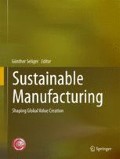Abstract
Every enterprise should track and asses its environmental impact for accountability reasons towards its consumers, employees, government, and society. The objective of this study is to design an eco-tracking framework and a decision support system architecture in order to provide energy visibility to enterprises by close monitoring the energy consumption of their manufacturing processes. The proposed architecture uses the energy consumption and production activity data as input. Energy consumption data is collected from meters and production activity data from manufacturing automation equipment (e.g. PLCs, CNCs, etc.). Collected energy data which is stored in a central data warehouse, is processed, contextualized with activity data and transformed to eco-KPIs in order to benchmark energy efficiency of the production processes and enable factory supervisors to make decisions towards better environmental footprint of the enterprise. The proposed decision support framework is founded on Software as a Service (SaaS) approach which can enable fast visibility of data throughout enterprise and provide easy scalability.
Access this chapter
Tax calculation will be finalised at checkout
Purchases are for personal use only
Preview
Unable to display preview. Download preview PDF.
References
United Nations, 1987, Report of the World Commission on Environment and Development, General Assembly Resolution 42/187, 11 December 1987
U.S. Department of Commerce, International Trade Administration, 2011, How does Commerce define Sustainable Manufacturing?, Available at: http://trade.gov/competitiveness/sustainablemanufacturing/how_doc_defines_SM.asp [Accessed 18 June 2011]
Rebitzer, G., Ekvall, T., Frischknecht, R., Hunkeler, D., Norris, G., Rydberg, T., Schmidt, W.-P., Suh, S., Weidema,.B.P., Pennington, D.W., 2004, Life cycle assessment Part 1: Framework, goal and scope definition, inventory analysis, and applications, Environment International, 30, 701–720
International Standards Organization, 1997, ISO 14040: Environmental management—Life cycle assessment - Principles and framework, Geneva, Switzerland
Hauschild, M., Jeswiet, J., Alting, L., 2005, From Life Cycle Assessment to Sustainable Production: Status and Perspectives, CIRP Annals – Manufacturing Technology, 54/2, 1–21
International Standards Organization, 1998, ISO 14041: Environmental management—Life cycle assessment - Goal and scope definition and inventory analysis, Geneva, Switzerland
International Standards Organization, 2000, ISO 14042: Environmental management—Life cycle assessment—Life cycle impact assessment, Geneva, Switzerland
U.S. Environmental Protection Agency, 2006, Life Cycle Assessment: Principles and Practice, EPA/600/R-06/060. National Risk Management Research Laboratory. Cincinnati, Ohio, USA
Pennington, D.W., Potting, J., Finnveden, G., Lindeijer, E., Jolliet, O., Rydberg, T., Rebitzer, G., 2004, Life cycle assessment Part 2: Current impact assessment practice, Environment International, 30, 721–739
Greenhouse Gas Protocol Initiative, 2004. A Corporate Accounting and Reporting Standard, Revised Edition, Available at: http://www.ghgprotocol.org/files/ghgp/publ ic/ghg-protocol-revised.pdf [Accessed 18 June 2011]
Herzog, T., 2009, World Greenhouse Gas Emissions in 2005, World Resources Institute, Available at http://www.wri.org/publication/navigating-the- numbers [Accessed 19 July 2011]
Jeswiet, J., Kara, S., 2008, Carbon Emissions and CESTM in Manufacturing, CIRP Annals—Manufacturing Technology, 57, 17-20
Ameta, G., Mani, M., Rachuri, S., Feng, S.C., Sriram, R.D., Lyons, K.W., 2009, Carbon Weight Analysis for Machining Operation and Allocation for Redesign, International Journal of Sustainable Engineering, 2/4, 241–251
The Economist Technology Quarterly, 2011, Following the Footprints, 13-15, Available at: http://www.economi st.com/node/18750670 [Accessed 19 July 2011]
Vezzoli, C., Manzini, E., 2008, Design for Environmental Sustainability, Springer – Verlag London Limited
Author information
Authors and Affiliations
Editor information
Editors and Affiliations
Rights and permissions
Copyright information
© 2012 Springer-Verlag Berlin Heidelberg
About this chapter
Cite this chapter
Uluer, M.U., Gök, G., Ünver, H.Ö., Kılıç, S.E. (2012). Towards a Decision Support Framework for Sustainable Manufacturing. In: Seliger, G. (eds) Sustainable Manufacturing. Springer, Berlin, Heidelberg. https://doi.org/10.1007/978-3-642-27290-5_12
Download citation
DOI: https://doi.org/10.1007/978-3-642-27290-5_12
Published:
Publisher Name: Springer, Berlin, Heidelberg
Print ISBN: 978-3-642-27289-9
Online ISBN: 978-3-642-27290-5
eBook Packages: Earth and Environmental ScienceEarth and Environmental Science (R0)

